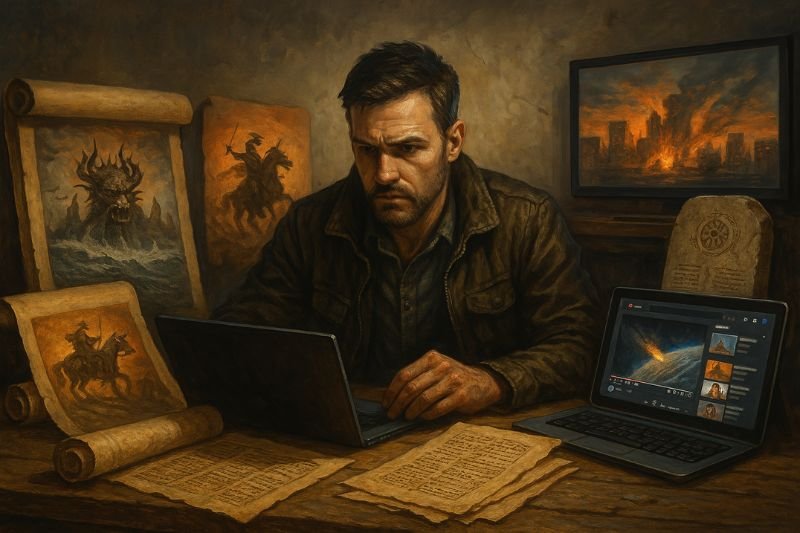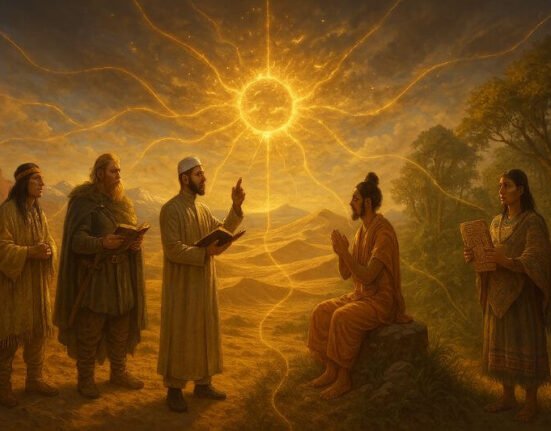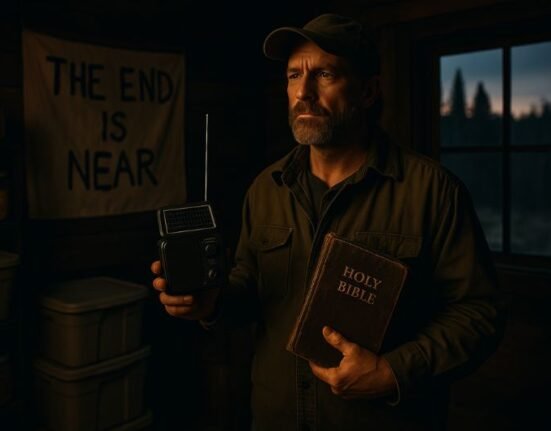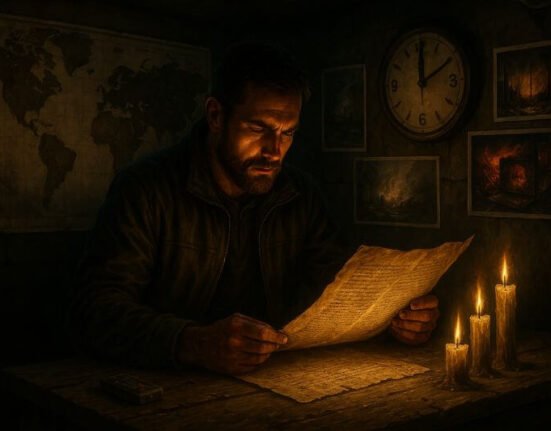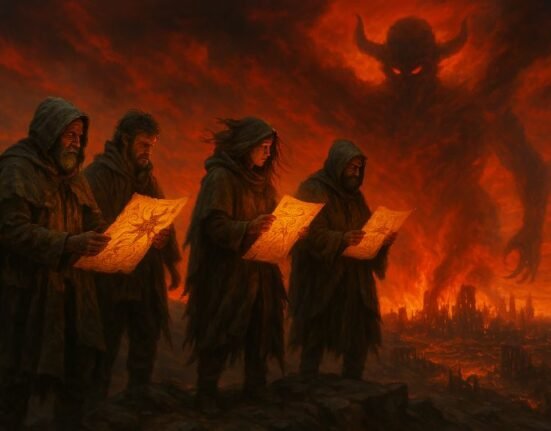Prophecy Meets Pop Culture: How Ancient Visions Became Blockbusters
For thousands of years, end-time prophecies were preserved in sacred texts, whispered through oral traditions, or carved into stone. Today, they’re streamed in high definition.
The rise of mass media has transformed end-time prophecies in media into a global phenomenon—reframing spiritual warnings as cinematic spectacle, viral TikTok trends, and doomsday entertainment. What began as apocalyptic scripture now drives billion-dollar franchises and internet rabbit holes.
But what does that say about us? And what are we really absorbing when prophecy is rebranded as fiction?
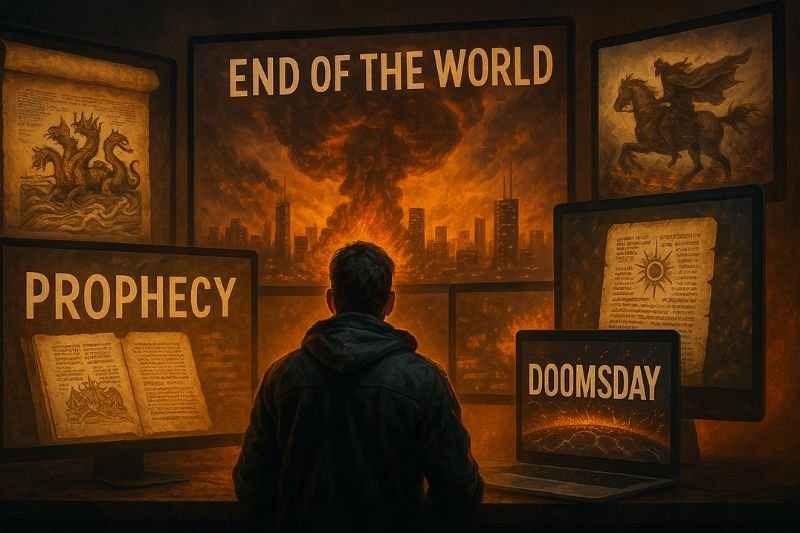
The Ancient Source Material
From the Book of Revelation to Hopi prophecy, ancient eschatology was rich with metaphors, moral codes, and symbolic cosmologies. Each culture imagined the end as a moment of reckoning—fire, flood, judgment, or renewal. These stories carried weight, guiding communities through times of war, famine, and upheaval.
But when these prophecies entered the age of mass communication, their tone and function shifted.
“Prophecy once called for repentance. Now it calls for ratings.” — Media critic A. Lowell
Prophecy Becomes Entertainment
The earliest cinematic depictions of apocalyptic prophecy, like The Ten Commandments (1956) or The Omen (1976), stuck closely to religious texts. But by the late 20th century, a new trend emerged: prophecy as entertainment format.
From Revelation-inspired plagues to Mayan calendar countdowns, media began to repackage prophetic elements into familiar genres:
- Disaster thrillers (2012, Armageddon)
- Post-apocalyptic dramas (The Road, The Book of Eli)
- Biblical allegories (Left Behind, The Rapture)
- Survival horror (The Walking Dead, 28 Days Later)
- Dystopian futures that blend prophecy with politics (Children of Men, Snowpiercer)
Each of these narratives recycles elements of ancient prophecy, but strips them of ritual, ethics, or context—leaving only fear and survival.
Cultural Consequences
Why does it matter?
Because when prophecy is reduced to plot, we risk confusing spectacle with significance. We become desensitized to collapse. Apocalyptic scenarios turn into background noise.
Yet for preppers and survivalists, this mass propagation of eschatological imagery serves another purpose: it normalizes preparedness. It makes the unthinkable more thinkable.
“We binge prophecy not because we believe it—but because deep down, we feel it’s possible.” — Survivalist media analyst, 2022
Media as the New Prophet: How Entertainment Rewrites the Apocalypse
In today’s hyperconnected world, media has become the primary narrator of collapse. Prophecy, once the domain of priests, mystics, or tribal elders, now flows through screenwriters, streamers, and social algorithms. But as prophecy meets profit, its shape—and purpose—changes.
From Sacred to Secular
When end-time prophecies in media are stripped of their sacred context, they become malleable story devices. Hollywood doesn’t need theological coherence—it needs emotional intensity, visual scale, and narrative conflict.
That’s why ancient symbols are often ripped from their origins and repurposed:
- The Beast of Revelation becomes a rogue AI or global dictator
- The Four Horsemen become climate events or mutated viruses
- The Mark becomes microchips, barcodes, or digital IDs
- Prophetic dreams become cinematic flash-forwards
While these adaptations are often compelling, they risk reducing prophecy to mere spectacle, erasing its moral, ritualistic, or redemptive dimensions.
“Hollywood wants the fire and brimstone—not the fasting and repentance.” — Cultural anthropologist C. Rivas
The Rise of Apocalyptic Franchises
Modern pop culture has birthed entire universes built on prophetic collapse:
- The Walking Dead explores moral erosion post-apocalypse
- The Leftovers reimagines the Rapture in a secular frame
- The Matrix hints at Gnostic prophecy cloaked in cyberpunk
- Children of Men reinterprets messianic prophecy through dystopian realism
- Black Mirror explores tech-driven doomsday with prophetic overtones
These narratives may lack formal religiosity, but they trigger the same emotional survival mechanisms: fear, awe, confrontation with the unknown.
Algorithmic Prophecy: When AI Becomes the New Oracle
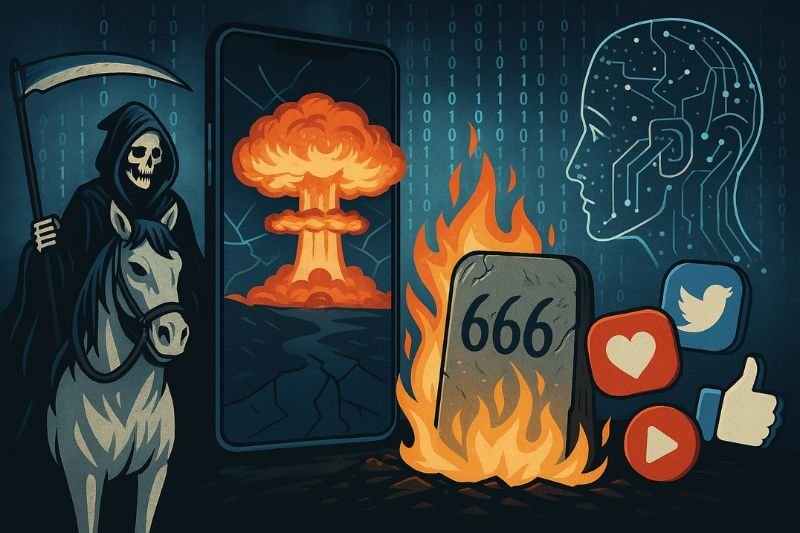
In the age of TikTok and YouTube, prophecy no longer requires scripture—it just needs a signal boost. Platforms are flooded with:
- AI-generated “end dates”
- Mashups of ancient texts + current headlines
- Astrological apocalypse predictions
- Viral clips predicting “Event X,” alien invasions, or elite-engineered doomsday
These digital-age prophecies reach millions in minutes, blending conspiracy, media aesthetics, and survival urgency.
➡️ For preppers, this media explosion is a double-edged sword:
- It spreads awareness, but also distorts priorities
- It validates fear, but may erode critical thinking
Prophetic Fiction, Real Behavior: How Media Fuels Modern Survivalism
The growing presence of end-time prophecies in media hasn’t just shaped entertainment—it’s reshaped how people behave. From TikTok survival influencers to doomsday bunker sales driven by Netflix specials, the echo of apocalypse is no longer passive. It’s performative. It’s preparatory.
Media is no longer just a reflection of prophetic fear—it’s now a trigger.
From Screen to Shelter: The Prepper Boom
Every time a major apocalyptic film trends on Netflix or a prophecy-themed documentary spikes on YouTube, there’s a ripple effect:
- Survival gear sales surge
- Traffic spikes on prepping forums
- TikTok challenges emerge about “last day” scenarios
- Conspiracy threads link media with hidden warnings
For example, after the release of Don’t Look Up (2021), several major prepping retailers reported a noticeable rise in first-time buyers. Why? Because people felt the satire was… too real.
“When entertainment mimics prophecy, even skeptics feel the urge to act.” — Survivalist trend analyst, 2023
Survivalism as Storytelling
Media has also taught preppers how to narrativize their preparations. The bunker isn’t just a shelter—it’s a setting. The bug-out bag isn’t just gear—it’s a prop. Apocalyptic fiction provides the script.
This is both helpful and dangerous:
- Helpful, because it creates visual templates that make prepping more accessible.
- Dangerous, because it may lead to dramatization over realism—fueling paranoia, not clarity.
Faith, Fear, and Fandoms
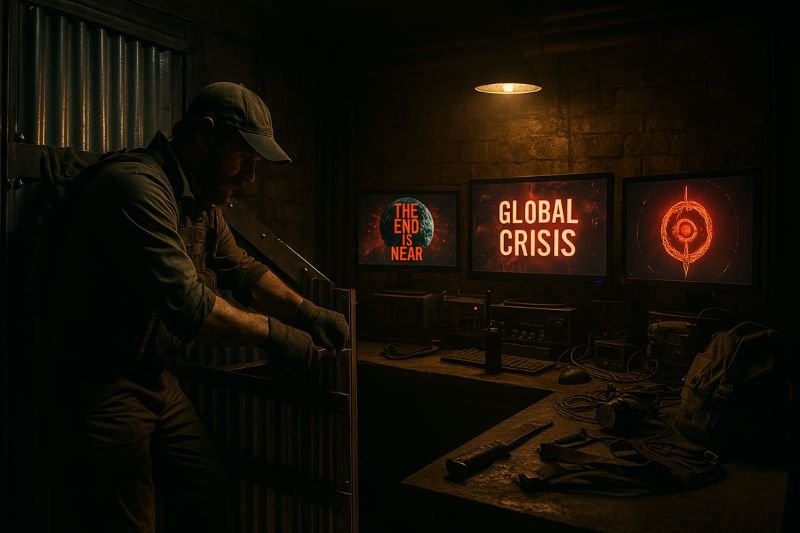
In some cases, end-time prophecies in media have created quasi-religious fandoms. Think:
- The Left Behind franchise → inspired literal prepping groups
- YouTube prophecy channels → command devoted followings
- TikTok “rapture date” influencers → trigger emotional panic cycles
- Reddit “Event X” theory groups → plan escape routes based on cryptic media cues
This convergence of prophecy + media + emotion builds a new kind of belief system—one that isn’t always based on facts, but is deeply felt, socially reinforced, and acted upon.
➡️ For the modern prepper, it’s crucial to distinguish between emotional resonance and actionable truth.
Final Thoughts: From Fiction to Forecast
End-time media isn’t just storytelling—it’s shaping the psychological architecture of collapse. What you watch, hear, or scroll through becomes a lens, framing how you perceive reality… and how you prepare for its end.
The key lesson? Don’t ignore media—but don’t be consumed by it either.
“Prophecy speaks. Media echoes. You decide what becomes action.”
🧠 Frequently Asked Questions (FAQ): The Impact of End-Time Prophecies in Media
Q1: Why are end-time prophecies so common in media today?
A: The rise of end-time prophecies in media isn’t just a coincidence—it reflects a deep cultural and psychological need. In times of global uncertainty, audiences gravitate toward narratives that dramatize collapse. Prophecy offers structure to chaos. It gives viewers a way to imagine not just the end of the world—but how it ends and why it matters.
Media producers understand this. Apocalyptic content sells because it taps into our fear, awe, and desire for survival. Whether it’s a Biblical rapture, a solar flare, or a viral outbreak, these stories mirror the anxieties we carry. And by wrapping them in fiction, they become easier to digest—even addicting.
Q2: Are modern films and series based on real prophetic texts?
A: Often, yes—but with creative liberties. Many popular movies and series borrow symbols, names, or themes directly from sacred texts:
- The Omen draws heavily on Revelation and the Antichrist figure.
- The Leftovers reimagines the Christian concept of the Rapture.
- Children of Men parallels messianic prophecy with a dystopian twist.
- The Book of Eli mixes scripture preservation with post-collapse survival.
However, these adaptations are rarely theologically accurate. They transform spiritual warnings into story arcs, flattening their complexity in the process.
This matters because it alters public perception of those texts. When people think of prophecy, they don’t picture Saint John—they picture CGI.
Q3: Do media portrayals of end-time prophecies influence real prepping behavior?
A: Yes—profoundly. The influence of end-time prophecies in media can be seen in everything from consumer habits to psychological readiness.
- After 2012 hit theaters, there was a spike in sales of survival gear, solar generators, and underground shelters.
- The Left Behind series spurred entire prepping ministries in evangelical circles.
- Even sci-fi media like Black Mirror or The 100 has fueled interest in off-grid living and EMP-proof tech.
This shows that fiction can drive fact. People don’t just watch prophecy—they act on it. Sometimes this leads to paranoia. But often, it leads to useful preparedness.
Q4: How do social media platforms amplify end-time narratives?
A: Platforms like TikTok, YouTube, and Reddit have become modern-day pulpits for prophecy—both sincere and speculative.
- TikTok users post “prophetic dreams” and rapture countdowns.
- YouTube channels interpret earthquakes and blood moons as signs of the end.
- Reddit forums like r/conspiracy link current events to hidden eschatological meanings.
This content spreads fast because it’s emotional and visual. Algorithms prioritize what grabs attention—and prophecy grabs it. The danger is that these messages often lack context, verification, or ethical grounding.
➡️ The result? Millions exposed to fragmented prophecy, repackaged for virality, often without discernment.
Q5: Can media-based prophecy be psychologically harmful?
A: It depends. When end-time prophecies in media are consumed without critical thinking, they can fuel:
- Anxiety and panic (e.g., fear of rapture dates, doomsday triggers)
- Paranoia about government, tech, or other communities
- Disempowerment, as people feel the future is predetermined
But for some, these stories offer emotional catharsis. They allow individuals to face their fears in a safe, narrative space. Survival fiction, in particular, can provide training for the mind: “What would I do in this situation?”
The key is balance. Use media prophecy as a stimulus for readiness—not a substitute for rational thinking.
Q6: Are there any benefits to prophecy-themed media for survivalists?
A: Definitely. Despite the risks, there are several practical benefits when handled wisely:
- Scenario visualization – Films and series present crisis models that can be reverse-engineered into survival plans.
- Mental conditioning – Exposure to collapse fiction reduces shock when facing real events.
- Community building – Shared viewing leads to forums, groups, and training circles.
- Cultural literacy – Knowing how prophecy is depicted helps you understand how others think and react.
For survivalists, media becomes a toolbox—not of tactics, but of mental templates. The stories you consume affect your reaction time, emotional readiness, and strategic logic.
Q7: How do filmmakers choose which prophecies to adapt?
A: Typically, they gravitate toward prophecies that are:
- Visually intense (e.g., plagues, horsemen, comets)
- Emotionally universal (fear of death, loss, redemption)
- Vaguely interpreted (allowing creative freedom)
- Tied to current events (for marketing relevance)
Revelation is a favorite because it’s full of symbolism, not strict doctrine. The same goes for Nostradamus—his quatrains are so open-ended they can be molded to almost any storyline.
Ultimately, filmmakers use prophecy as a canvas, not a contract.
Q8: Should survivalists trust media-based interpretations of prophecy?
A: No—not blindly. Treat all media content as fiction first, symbolism second. Even when a series claims to be “based on scripture,” it often prioritizes:
- Narrative pacing over theological accuracy
- Sensationalism over spiritual meaning
- Marketability over moral clarity
However, you can extract meaning if you know what you’re looking for. Use media as a starting point for study, not an endpoint for belief.
➡️ Always ask: What’s the source? What’s the agenda? What’s the application to real-world prepping?
Q9: Are there media examples that handle prophecy with depth and nuance?
A: Yes. A few standout examples go beyond clichés:
- The Leftovers explores emotional and spiritual fallout from a prophetic event with complexity.
- Children of Men ties fertility collapse to messianic expectations in a secular world.
- The Road captures existential prepper dread in a prophetic tone without naming it as such.
These stories don’t just predict the end—they contemplate it, morally and psychologically. That’s the kind of content worth dissecting.
Q10: What’s the future of prophecy in media?
A: As crises escalate—climate change, AI disruption, war—expect prophecy to become even more central to entertainment. New formats like:
- Interactive apocalypse games
- AI-generated prophecy series
- Deepfake prophets and virtual cults
The next frontier of end-time prophecies in media may blur the line between fiction and influence even more dangerously. Preppers must stay aware, informed, and critical.









